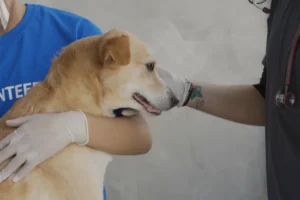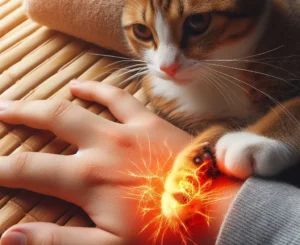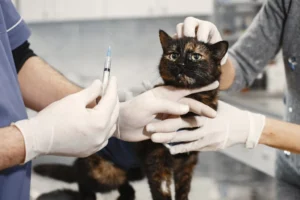You’ve noticed your cat scratch isn’t healing as quickly as you expected. But why is that? Let’s find out.
Have you ever wondered why some cat scratches seem to take forever to heal? In this blog post, we will explore the reasons why your cat scratch may not be healing as quickly as you’d like, and what you can do to help it along.
Possible Reasons for Delayed Healing
If your cat scratch is taking longer to heal than expected, several factors could be at play. One common reason is that the scratch may have become infected. Infections can slow down the healing process, leading to persistent redness, swelling, or discharge. It’s essential to keep an eye on these symptoms and seek veterinary care if they persist.
Another possible reason for a slow-healing cat scratch is inadequate wound care. Failure to clean the wound regularly or not applying proper ointments can hinder the healing process. Additionally, if your cat keeps scratching at the wound, it can reopen, leading to further delays in healing.
Moreover , certain underlying health conditions, such as diabetes or immune disorders, can also impact the body’s ability to heal wounds. If you suspect that your cat scratch is not healing due to an underlying health issue, it’s crucial to consult with a healthcare professional.
Proper Wound Care for Cat Scratches
Proper wound care is crucial for ensuring that cat scratches heal promptly and without complications. First and foremost, clean the scratch with mild soap and water to remove any debris or bacteria. Preventative measures such as keeping your cat’s nails trimmed can reduce the risk of deep scratches that are more prone to infection.
Additionally, applying an antibiotic ointment to the wound can promote healing and prevent infections. Covering the scratch with a bandage can also protect it from further irritation and aid in the healing process. Remember to change the bandage regularly and keep the area clean and dry.
It’s important to monitor the scratch for any signs of infection, such as increased redness, swelling, or pus. If you notice these symptoms or if the scratch does not seem to be improving, seek veterinary advice promptly.
For more information on proper wound care for cat scratches, you can visit the American Veterinary Medical Association’s guide on wound management here.
Signs of Infection to Watch For
If your cat scratch is not healing, you should watch out for signs of infection. Look for redness, swelling, warmth, or pain around the wound. If you notice pus or a foul odor coming from the scratch, these are also signs that infection may be present. Additionally, if your cat seems lethargic, feverish, or is not eating well, it could indicate an infection that is hindering the healing process. If you observe any of these symptoms, it is crucial to seek veterinary care promptly to prevent further complications.
Importance of Veterinary Care
Seeking veterinary care is essential if your cat scratch is not healing properly. A veterinarian can assess the wound, determine if an infection is present, and prescribe the appropriate treatment. They may need to clean the wound, provide antibiotics, or recommend additional care to promote healing. Delaying veterinary intervention can lead to the infection worsening, making it harder for the scratch to heal. Remember, your cat’s health and well-being should always be a top priority, so don’t hesitate to seek professional help if needed.
Extra Tip: Keep the scratch clean and dry to help prevent infection. Use mild soap and water to gently clean the wound, and avoid covering it with bandages unless recommended by your veterinarian.
How Diet Can Impact Healing
Is your cat’s scratch taking longer to heal than expected? It might be time to take a closer look at their diet. A balanced diet rich in essential nutrients plays a crucial role in promoting healing and overall health for your furry friend. Make sure your cat’s food contains adequate levels of protein, as it is essential for tissue repair. Incorporating omega-3 fatty acids can also help reduce inflammation and support healing. Additionally, ensure your cat stays hydrated as water is vital for the healing process.
For further insight on how diet can impact your cat’s healing process, check out this helpful resource on cat nutrition.
Preventing Future Scratches
Looking to prevent future scratches and promote faster healing for existing ones? Start by trimming your cat’s claws regularly to minimize the damage from accidental scratches. Providing scratching posts and toys can help redirect your cat’s natural urge to scratch onto more appropriate surfaces. Keep your cat’s environment enriched and engaging to reduce stress and potential triggers for scratching. If your cat is prone to scratching, consider using soft paws or nail caps to prevent injuries. Remember, a happy and healthy cat is less likely to engage in aggressive scratching behavior.
- Trim your cat’s claws regularly to prevent deep scratches.
- Provide scratching posts and toys to redirect scratching behavior.
- Keep your cat’s environment enriched and stress-free to minimize scratching incidents.
- Consider using soft paws or nail caps for added protection against scratches.
By following these tips and tricks, you can help your cat heal faster and reduce the likelihood of future scratches.
Understanding Cat Behavior
When it comes to understanding why your cat scratch is not healing, it’s essential to consider your cat’s behavior. Cats are known for their grooming habits, which involve licking their wounds to clean them. However, this behavior can sometimes be counterproductive when it comes to scratches. Excessive licking can actually irritate the wound further, leading to delayed healing.
To address this issue, it’s important to observe your cat’s behavior and take steps to prevent over-grooming. One way to do this is by using a protective collar to prevent your cat from accessing the scratch. Additionally, keeping the scratch clean and dry can help promote faster healing. By being aware of your cat’s behavior and taking preventative measures, you can help ensure that the scratch heals properly.
Interesting Facts About Cat Scratches
Did you know that a cat’s scratch contains bacteria that can lead to infection if not properly treated? It’s important to clean a cat scratch promptly to reduce the risk of infection. Additionally, cat scratches are not only a result of aggression but can also occur during playtime when your cat’s excitement levels are high.
Furthermore, cat scratches are often accompanied by a substance in their claws that can cause irritation in human skin. This can result in prolonged healing time for cat scratches on humans. Therefore, it’s crucial to clean the scratch thoroughly and monitor it closely for any signs of infection.
Additional Insight: Cats scratch as a way to mark their territory and maintain their claws, so it’s essential to provide your cat with appropriate scratching posts to prevent them from scratching furniture or other surfaces. By understanding the reasons behind your cat’s scratching behavior, you can better address any issues that may be hindering the healing process.
Alex, a passionate animal lover, has experience in training and understanding animal behavior. As a proud pet parent to two dogs and three cats, he founded AnimalReport.net to share insights from animal experts and expand his knowledge of the animal kingdom.









